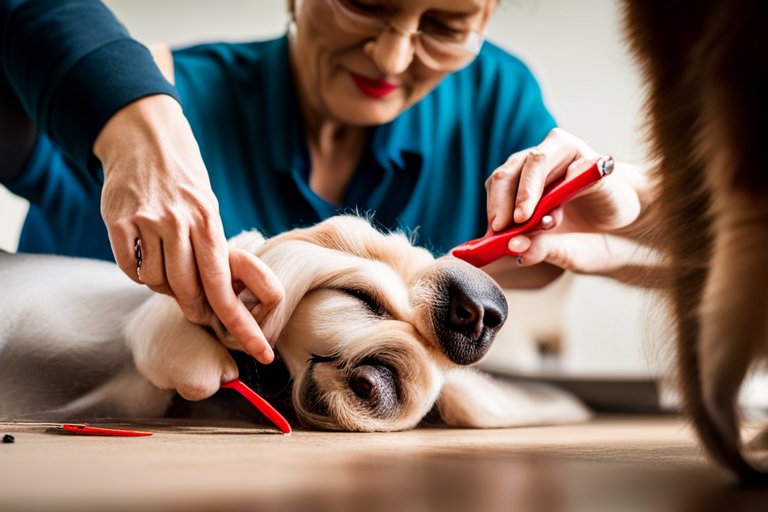
Dog Nail Trimming: As a responsible dog owner, it’s crucial to prioritize your pup’s nail care. Regular nail trimming is not only a grooming task but also an essential part of maintaining your dog’s overall health and well-being. However, for some dogs, the nail-trimming process can be a source of extreme anxiety and fear. In such cases, sedation can be a helpful tool to ensure a stress-free experience for both you and your furry friend. In this comprehensive guide, we’ll explore various methods and techniques to sedate your dog for nail trimming, providing you with the knowledge and tools to make this process easier and safer.
Why Nail Clipping is Important for Dogs
Before delving into the sedation techniques, let’s first understand why nail clipping is crucial for dogs. Overgrown nails can lead to a variety of problems, ranging from discomfort to serious health issues. Canine nails grow in a curved pattern, and if left untrimmed, they can eventually grow into the footpad. This causes pain, and irritation, and increases the risk of injury. Additionally, long nails can easily break, leading to sharp pain, bleeding, and potential infections. Nail infections can be particularly severe, sometimes spreading to the toe bone and necessitating amputation.
Furthermore, neglecting to trim your dog’s nails can result in the elongation of blood vessels and nerves within the nails, commonly known as the “quick.” Accidentally cutting the quick can cause bleeding and intense pain for your dog. Infections can also develop at the site of the cut quickly. Therefore, it’s essential to keep your dog’s nails at an appropriate length to prevent these issues from occurring.
Is Sedation Necessary for Nail Clipping?
Sedation is not always necessary for nail clipping, but it can be beneficial in certain situations. Some dogs may have extreme anxiety or aggression when it comes to nail trimming, making it difficult to safely perform the task. Dogs with past traumatic experiences or those who have had their accidentally cut in the past may also exhibit fear and resistance during nail clipping. In these cases, sedation can help calm the dog and make the process more manageable.
However, it’s important to note that sedation should only be used as a last resort. It’s crucial to work on training and desensitization techniques to help your dog become more comfortable with nail trimming. Sedation should be seen as a temporary solution while you work on building trust and confidence with your dog. Always consult with your veterinarian before considering sedation for nail clipping, as they can provide guidance on the best course of action for your specific dog.
Sedation Options for Nail Clipping
There are several methods and products available to sedate dogs for nail clipping. The choice of sedation will depend on your dog’s individual needs and the severity of their anxiety. It’s important to consult with your veterinarian to determine the most appropriate option for your dog. Here are some common sedation options:
1. Over-the-Counter Sedatives
Over-the-counter sedatives can be a practical solution for calming your dog during nail trimming. These sedatives are typically milder and have fewer potential side effects compared to prescription medications. However, it’s crucial to follow the recommended dosage for your dog’s size and consult with your veterinarian before using any over-the-counter sedative. Here are a few examples of over-the-counter sedatives:
- Benadryl: Benadryl, an antihistamine, can have a mild sedating effect on dogs. It helps calm nervousness and anxiety, making it useful for nail-trimming sessions.
- Melatonin supplements: Melatonin is a hormone that helps regulate sleep patterns. It can also have a calming effect on dogs, making it a potential option for reducing anxiety during nail clipping.
- Natural sedation methods: Some herbs, such as chamomile, valerian, or California poppy, have natural relaxing properties. These herbs can be used to create calming teas or added to treats to help relax your dog before nail trimming.
2. Prescription Medications
In more severe cases of anxiety or aggression, your veterinarian may prescribe stronger sedatives to ensure a safe and stress-free nail-trimming experience. These prescription medications should only be used under the guidance of a veterinarian, as they require careful dosing and monitoring. Common prescription sedatives for dogs include:
- Diazepam (Valium): Diazepam is a sedative that can help reduce anxiety and induce relaxation. It should only be used under veterinary supervision due to its potency and potential side effects.
- Acepromazine: Acepromazine is a tranquilizer commonly used in veterinary medicine. It can help calm anxious dogs and make them more manageable during nail clipping.
3. Calming Products and Techniques
In addition to medications, there are various calming products and techniques that can help relax your dog during nail trimming. These methods can be used in conjunction with sedation or as standalone options for dogs with mild anxiety. Here are a few examples:
- Aromatherapy: Some essential oils, such as lavender oil, have calming properties and can help relax your dog. Use a diffuser or apply a small amount of diluted oil to create a calming atmosphere during nail trimming.
- Pheromone sprays: Pheromone sprays mimic natural dog pheromones and can help create a sense of calm and security. Spray the product in the room before nail trimming to help reduce anxiety.
- Counter-conditioning and desensitization: Training techniques such as counter-conditioning and desensitization can help your dog associate nail trimming with positive experiences. Gradually introduce the nail clipping process, reward your dog with treats and praise, and gradually increase the level of handling over time.
- Behavioral training: Working with a professional dog trainer or behaviorist can provide valuable guidance and support in addressing your dog’s anxiety and fear surrounding nail trimming. They can help develop a personalized training plan to help your dog overcome their fear gradually.
Nail Trimming Techniques for Sedated Dogs
Once your dog is appropriately sedated and relaxed, it’s essential to follow proper nail-trimming techniques to ensure a safe and effective procedure. Here are some guidelines to help you trim your dog’s nails:
1. Gather the Necessary Tools
Before starting the nail trimming process, gather all the necessary tools. You will need a pair of dog nail clippers or a nail grinder, styptic powder or cornstarch (in case of bleeding), and treats as rewards for your dog’s cooperation.
2. Choose a Comfortable Environment
Find a quiet and comfortable area where you can perform the nail trimming. This can be a well-lit room with minimal distractions. Creating a calm environment will help reduce your dog’s anxiety levels.
3. Handle Your Dog Gently
Approach your sedated dog calmly and gently. Speak in a soothing tone and avoid sudden movements that could startle them. It’s crucial to maintain a relaxed and positive atmosphere throughout the process.
4. Gradually Introduce the Tools
Introduce the nail clippers or grinder to your dog, allowing them to sniff and become familiar with the tools. Reward any calm behavior with treats and praise to reinforce positive associations.
5. Start Slowly
Begin the nail-trimming process slowly and carefully. If using clippers, make small, controlled cuts to avoid cutting the quick. If using a grinder, gently touch the grinder to the nail to gradually shorten it. Take breaks as needed to ensure your dog remains calm and comfortable.
6. Monitor the Quick
Be sure to focus on the fast, painful area around the nail that has blood vessels and nerves. It’s essential not to cut into the quick, as doing so can lead to bleeding and discomfort. If you are uncertain, ask your vet or a professional groomer for advice.
7. Reward and Praise
Throughout the nail-trimming process, reward your dog with treats and praise for their cooperation and calm behavior. Positive reinforcement will help create positive associations with nail trimming and make future sessions easier.
8. Be Prepared for Bleeding
In the event of accidental bleeding, have styptic powder or cornstarch on hand to stop the bleeding. Apply a small amount to the bleeding nail and apply gentle pressure until the bleeding stops. If bleeding persists or if you’re unsure, contact your veterinarian for further assistance.
9. Take Breaks as Needed
If your dog becomes anxious or stressed during the nail-trimming process, take breaks as needed. It’s important not to rush the procedure and prioritize your dog’s comfort and well-being.
10. Follow Up with Rewards and Relaxation
After completing the nail trimming session, continue to reward your dog with treats and praise. Allow them time to relax and decompress after the procedure. This positive reinforcement will help create positive associations with nail trimming in the future.
Additional Tips for Successful Nail Trimming
In addition to sedation and proper techniques, here are some additional tips to ensure a successful and stress-free nail-trimming experience for your dog:
1. Start Early and Gradually
Begin nail trimming sessions when your dog is young to help them become accustomed to the process. Gradually introduce them to the tools and handling, making it a positive and routine part of their grooming routine.
2. Regularly Exercise Your Dog
Regular exercise helps to naturally wear down your dog’s nails, reducing the frequency and difficulty of nail trimming sessions. Daily walks and playtime on hard surfaces can help keep their nails at a manageable length.
3. Seek Professional Help if Needed
If you’re still struggling with nail trimming despite sedation and training efforts, consider seeking assistance from a professional groomer or veterinarian. They have the expertise and experience to safely and efficiently trim your dog’s nails.
4. Stay Calm and Patient
Your dog can sense your emotions, so it’s crucial to remain calm and patient during the nail-trimming process. If you’re anxious or stressed, your dog may become more anxious as well. Take deep breaths, use a soothing tone, and provide reassurance to your dog throughout the procedure.
5. Consider Professional Nail Grinding
If your dog is particularly sensitive to nail clippers, you may opt for professional nail grinding instead. Nail grinders use a rotating abrasive surface to gradually shorten the nails, providing a smoother and less stressful experience for your dog.
FAQs About Sedating Dogs For Nail Trimming
1. Why would I need to sedate my dog for nail trimming?
- Sedation can help calm anxious dogs, making the process safer and more comfortable for both the dog and the owner.
2. What is the cost range for sedating a dog for nail trimming?
- The cost can vary from $50 to $200 per session, depending on factors such as the dog’s size and the type of sedation used.
3. What factors should I consider before sedating my dog for nail trimming?
- You should consider your dog’s specific needs, health, and temperament, and consult with a veterinarian to determine if sedation is necessary.
4. Are there alternatives to sedation for nail trimming?
- Yes, alternatives include desensitization training, calming techniques, professional grooming, and regular exercise to naturally wear down nails.
5. What are the potential risks of sedating my dog for nail trimming?
- Common side effects may include drowsiness and reduced coordination, but severe side effects are rare and should be discussed with your veterinarian.
6. How can I prepare my dog for sedation for nail trimming?
- Consult with your vet, follow fasting instructions, create a stress-free environment, administer medication as directed, and monitor your dog post-sedation.
7. How do I find a qualified veterinarian for sedating my dog?
- Seek recommendations, research credentials and experience, schedule a consultation, consider the clinic’s facilities, and trust your instincts.
8. What are the advantages of oral sedation for nail trimming?
- Oral sedation is convenient for mild to moderate sedation, and the medication takes effect within about 30 minutes to an hour.
9. When is injectable sedation recommended for nail trimming?
- Injectable sedation is used for highly anxious or resistant dogs, providing a deeper level of sedation with rapid onset.
10. What is inhalant sedation, and when is it suitable for nail trimming?
- Inhalant sedation involves gas anesthesia and is suitable for dogs of various sizes and temperaments, offering precise control over sedation levels.
11. Can sedation be used for every nail trimming session?
- It depends on your dog’s nail growth rate; for dogs with rapid growth, it may not be practical, and alternative methods should be considered.
12. How can I safely trim my dog’s nails without sedation?
- Start early, use appropriate tools, trim gradually, reward with treats, and seek professional guidance when needed.
13. Can I sedate my dog at home for nail trimming?
- Sedation should only be administered by a qualified veterinarian to ensure safety and proper dosage.
14. What are some signs that my dog may need sedation for nail trimming?
- Signs include extreme anxiety, aggression, or resistance during nail-trimming sessions.
15. Are there specific breeds more prone to needing sedation for nail trimming?
- Any dog breed can benefit from sedation if they have a strong aversion to nail trimming, but it’s not breed-specific.
16. How long does the sedation effect last during a nail trimming session?
- The duration varies depending on the type of sedation used but typically ranges from a few minutes to a few hours.
17. Can I use over-the-counter sedatives for my dog’s nail trimming?
- It’s not recommended to use over-the-counter medications without veterinary guidance, as they may not be safe or effective.
18. What should I do if my dog experiences side effects from sedation?
- Contact your veterinarian immediately if you notice any unusual symptoms or side effects.
19. Is sedation necessary for all dogs, or can some be trained to tolerate nail trimming without it?
- Not all dogs require sedation; some can be trained through desensitization to tolerate nail trimming.
20. How often should I trim my dog’s nails to avoid the need for sedation?
- Nail trimming frequency varies by dog and activity level, but regular checks and trimming can help prevent overgrown nails.
Conclusion
Nail trimming is an essential aspect of dog grooming and overall health. While some dogs may require sedation to make the process more manageable, it’s important to prioritize training and desensitization techniques to help your dog become comfortable with nail trimming. Remember to always consult with your veterinarian before using any sedatives or medications and follow proper techniques to ensure a safe and stress-free experience for both you and your furry friend. With patience, positive reinforcement, and proper care, you can successfully trim your dog’s nails and promote their overall well-being.
Disclaimer: This article is for informational purposes only and should not replace professional veterinary advice. Always consult with a veterinarian before making any decisions regarding your dog’s health and well-being.






